Tuesday, August 23, 2005
Today is our work train day! You bet your hard hat I'm excited!
The alarm clock nudges me out of bed at 5:00 am. Randy and I pack monster
size
lunches (after all we're working guys today!) and we are on the road by 6:00
am. The traffic is surprisingly light in downtown Anchorage. Eventually,
we
escape the bonds of the city and enter the beautiful Alaskan countryside. As
we approach Trapper creek, we catch a glimpse of a mother bear and two cubs
running across the road.
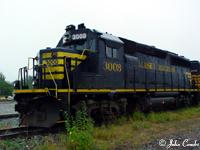 Mother
Nature begins to bless us with liquid sunshine as we turn onto the road to Hurricane
section house. We pull in at 9:05 am, don rain gear and photograph anything
with an Alaska Railroad logo on it. At 9:45 am, the work crew arrives: locomotive
engineer Frank Dewey, conductor Ricky Singsaas, brakeman Duane Frank, heavy
equipment operator Derek Winchester and engineering supervisor Rich Holzapfel.
Frank has on a black jacket partially covering his orange shirt and the crew
jokes he is dressed up for Halloween. Frank fires up GP40 numbers 3006 and 3008
and then asks Randy and I to guess how much a tank of fuel costs for one of
these locomotives. Next time you fill up your tank, rejoice in the fact that
it didn't cost you $16,000.
Mother
Nature begins to bless us with liquid sunshine as we turn onto the road to Hurricane
section house. We pull in at 9:05 am, don rain gear and photograph anything
with an Alaska Railroad logo on it. At 9:45 am, the work crew arrives: locomotive
engineer Frank Dewey, conductor Ricky Singsaas, brakeman Duane Frank, heavy
equipment operator Derek Winchester and engineering supervisor Rich Holzapfel.
Frank has on a black jacket partially covering his orange shirt and the crew
jokes he is dressed up for Halloween. Frank fires up GP40 numbers 3006 and 3008
and then asks Randy and I to guess how much a tank of fuel costs for one of
these locomotives. Next time you fill up your tank, rejoice in the fact that
it didn't cost you $16,000.
Today, the work crew will be dropping concrete ties along the
right-of-way in preparation laying continuous
welded rail. Since the fourth of July, this crew has worked seven days a
week and will continue to do so until winter puts a stop to their work. We hop
aboard #3006 and pick up caboose 1087 at Chulitna and the excavator, flat cars
with ties and other stuff at Sherman. It is now time to transfer to the caboose
and Randy and I eagerly climb on board. The caboose has all the comforts of
a home away from home such as fuel oil stove, generator, microwave oven, coffee
pot, food and bottled water.
 One
of Randy's lifetime goals is to ride in the cupola of the caboose. Once we are
underway, he scampers up the steps and into the seat. He later reports this
is one of the happiest days of his life, only second to his wedding. [click
here to view the 648KB video] By the time we get to MP 252 to start dropping
ties, it begins to rain steadily. After going into a siding, Rich helps Derek
connect the concrete tie lift to the end of the excavator. Soon the northbound
Denali Star comes rolling past and I take some of the closest train video of
my life.
One
of Randy's lifetime goals is to ride in the cupola of the caboose. Once we are
underway, he scampers up the steps and into the seat. He later reports this
is one of the happiest days of his life, only second to his wedding. [click
here to view the 648KB video] By the time we get to MP 252 to start dropping
ties, it begins to rain steadily. After going into a siding, Rich helps Derek
connect the concrete tie lift to the end of the excavator. Soon the northbound
Denali Star comes rolling past and I take some of the closest train video of
my life.
Heading back onto the mainline, the crew swings into action.
Rich helps to direct Derek in positioning the concrete tie lift over a row
of concrete ties. Working in parallel, Duane removes the ratchet straps and
cuts the metal strapping on the next load of concrete ties. Frank stops the
locomotive and Derek's excavator slowly lowers a set of ties to the ground.
[click here to
view the 2.0MB video] Frank then powers up the locomotives to move us
another 50 feet down the line. Ricky monitors their activity from the warm,
dry caboose (a tough job, but sombody has to do it, right?).
The group works in an efficient, natural rhythm that obviously speaks of their
professionalism. Once a flatcar is unloaded, the excavator moves from the
top
of one flatcar to the next. There is very little room for error, but Derek
does the job without a hitch.
 |
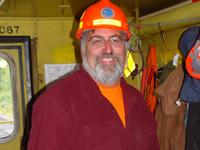 |
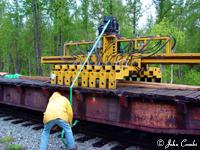 |
| Lots of concrete ties to deliver |
Derek Winchester |
Unstrapping the tie lifter |
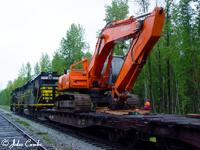 |
 |
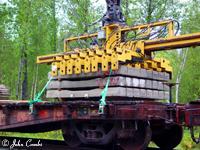 |
| Excavator |
Connecting the tie lifter |
Ready! |
 |
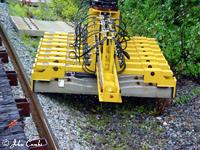 |
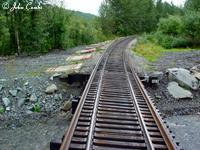 |
| Unloading the ties... |
and putting them on the ground... |
to be installed by another crew |
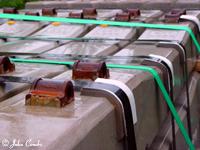 |
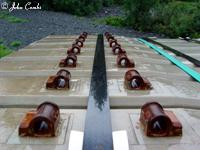 |
|
| Rachet and metal straps |
An artsy kind of photo |
|
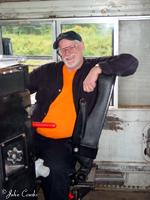 Soon
everyone breaks for lunch. There is a lot of joking, laughter and poking
fun at one another. This is truly a magical crew. Randy and I take a cup
of hot coffee up to Frank in the locomotive.
Over the next 45 minutes, Frank talks about the SD70MACs. In layman's terms,
the
new MACs (circa 2004) have received a lot of electronic enhancements and thus
talk at a teenage level. The old MACs (circa 2000) talk on an eight-year-old
level.
Therefore, pairing older and newer MACs together results in communication problems.
Fortunately, the railroad hired a former EMD MAC whiz and he has been great
in dealing with all the idiosyncrasies of these complex pieces of equipment.
Frank also thinks someone should design a single machine that pulls old rail
and ties and then lays new concrete ties and continuous welded rail. This
would
replace about a dozen machines currently doing the various tasks now.
Soon
everyone breaks for lunch. There is a lot of joking, laughter and poking
fun at one another. This is truly a magical crew. Randy and I take a cup
of hot coffee up to Frank in the locomotive.
Over the next 45 minutes, Frank talks about the SD70MACs. In layman's terms,
the
new MACs (circa 2004) have received a lot of electronic enhancements and thus
talk at a teenage level. The old MACs (circa 2000) talk on an eight-year-old
level.
Therefore, pairing older and newer MACs together results in communication problems.
Fortunately, the railroad hired a former EMD MAC whiz and he has been great
in dealing with all the idiosyncrasies of these complex pieces of equipment.
Frank also thinks someone should design a single machine that pulls old rail
and ties and then lays new concrete ties and continuous welded rail. This
would
replace about a dozen machines currently doing the various tasks now.
Just as our lunch break is over, the rain stops! Work resumes
and we continue to unload more ties. Due to an approaching southbound Denali
Star, we again take a siding and wait. I figure that due to increase train traffic,
the work crews probably get less done and spend more time in a work stoppage
mode. Soon the crew gives the passenger train a roll by inspection and then
gets back out onto the main to resume work.
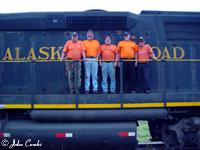 After
unloading several more stacks of ties, the excavator quits without warning.
Derek is unable to fix it so the crew packs it in for the day. We drop back
into a siding to wait for a northbound oil train [click
here to view the 1.6MB video] and then return the equipment to its
appropriate siding. The caboose is in the lead and Duane must use a hand
held air horn to blow when necessary. As we approach Hurricane, Mother
Nature
gives us a beautiful rainbow, a very appropriate ending to our day. It
is amazing
how fast the
hours
have
passed. I love this kind of work! I could sit and watch it all day! We
finish
with a group photo at Hurricane. There are handshakes all around and I have
a strong feeling of sadness as we depart.
After
unloading several more stacks of ties, the excavator quits without warning.
Derek is unable to fix it so the crew packs it in for the day. We drop back
into a siding to wait for a northbound oil train [click
here to view the 1.6MB video] and then return the equipment to its
appropriate siding. The caboose is in the lead and Duane must use a hand
held air horn to blow when necessary. As we approach Hurricane, Mother
Nature
gives us a beautiful rainbow, a very appropriate ending to our day. It
is amazing
how fast the
hours
have
passed. I love this kind of work! I could sit and watch it all day! We
finish
with a group photo at Hurricane. There are handshakes all around and I have
a strong feeling of sadness as we depart.
Randy
and
I
drive to Greg’s
(a friend of Randy's) home just outside of Denali
National Park. Although
Greg is not home, he has left Randy a key. After catching up in my journal
I head for bed at 9:16 pm.
Day 9 | Index
| Day 11
 Mother
Nature begins to bless us with liquid sunshine as we turn onto the road to Hurricane
section house. We pull in at 9:05 am, don rain gear and photograph anything
with an Alaska Railroad logo on it. At 9:45 am, the work crew arrives: locomotive
engineer Frank Dewey, conductor Ricky Singsaas, brakeman Duane Frank, heavy
equipment operator Derek Winchester and engineering supervisor Rich Holzapfel.
Frank has on a black jacket partially covering his orange shirt and the crew
jokes he is dressed up for Halloween. Frank fires up GP40 numbers 3006 and 3008
and then asks Randy and I to guess how much a tank of fuel costs for one of
these locomotives. Next time you fill up your tank, rejoice in the fact that
it didn't cost you $16,000.
Mother
Nature begins to bless us with liquid sunshine as we turn onto the road to Hurricane
section house. We pull in at 9:05 am, don rain gear and photograph anything
with an Alaska Railroad logo on it. At 9:45 am, the work crew arrives: locomotive
engineer Frank Dewey, conductor Ricky Singsaas, brakeman Duane Frank, heavy
equipment operator Derek Winchester and engineering supervisor Rich Holzapfel.
Frank has on a black jacket partially covering his orange shirt and the crew
jokes he is dressed up for Halloween. Frank fires up GP40 numbers 3006 and 3008
and then asks Randy and I to guess how much a tank of fuel costs for one of
these locomotives. Next time you fill up your tank, rejoice in the fact that
it didn't cost you $16,000. 












